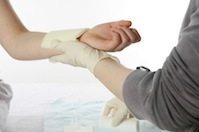Home Wound Care That Is As Good As Any Hospital
These days, many patients are discharged prematurely from the hospital. Home care nurses and community health workers may be overwhelmed caring for patients with complicated wounds for home wound care. Patients who have less complicated wounds are often discharged home to care for their own wounds with little instruction as to how they can facilitate wound healing. As a health care professional, you may be called upon to provide home wound care teaching to patients being readied for discharge.
What should you tell these patients about Home Wound Care?
- Keep the wound covered until it is no longer draining- keeping the wound covered will help to prevent infection. You may need to instruct the patient on how to change their dressing, how often to change it and signs and symptoms of infection to watch for.
- Follow instructions regarding showering- while it may be safe to shower with some wounds almost immediately, it may not be advisable to shower with other types of wounds; always follow physician’s orders.
- Avoid soaking in hot tubs or swimming pools – soaking the wound in unclean environments may lead to infection, which may slow the healing process. Some wounds may benefit from soaking in a basin or whirlpool, so you should follow physician’s orders when providing advice regarding soaking of a wound.
- Avoid removing scabs- picking at scabs may remove not only the scab, but also any newly granulated tissue beneath the scab. Instruct patients to leave scabs alone to fall off naturally. Picking at scabs may also increase scarring. Any debriding of the wound should be performed by a professional, not the patient!
- Eat a healthy diet- eating a diet high in protein, low in sugar and high in fruits, whole grain and vegetables will provide the body with all of the nutrients it needs to heal quickly and fight infection.
- Keep blood sugar levels under control- instruct diabetics to tightly control their blood sugar to hasten healing time and prevent infection. Uncontrolled diabetes will prolong wound healing and may render the wound more susceptible to infection.
- Use clean technique when changing dressings- most individuals can be taught clean technique. Remind the individual to store dressing supplies in a clean, dry place and change dressings in a relatively clean area. Antibacterial soap can be used to wash the hands and surfaces prior to dressing changes.
Instruct the client to report any signs of infection, such as increased pain, redness, drainage or odor coming from the wound.
Using these simple tips, clients can be taught to provide their own wound care that is as good as any hospital. With your support, clients can manage their wound care at home without suffering any complications.
Learn More About Wound Management
If you are interested in learning more about wound dressings, consider achieving wound care certification. WoundEducators.com offers wound care certification courses that you can complete at your own pace, in the comfort of your own home. For more information view our wound care certification courses.

